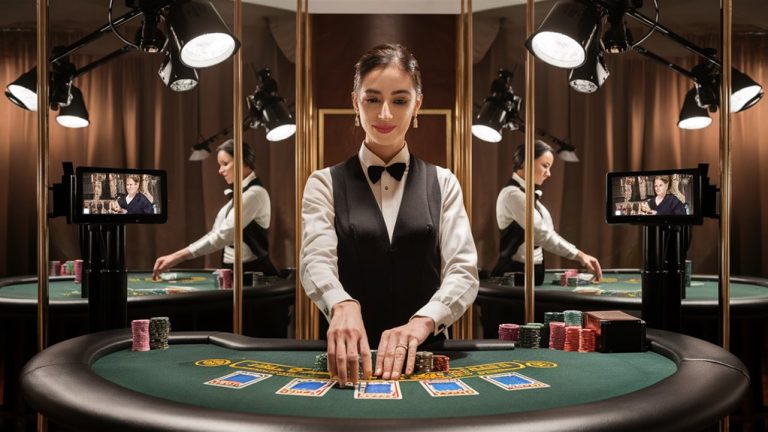
How Pro Gamblers Trick with Mind Games

Spotting Body Signs
Pro gamblers watch closely for small face moves and set moves to guess the real cards someone holds. These quick hints, some that last less than a blink, tell a lot about card quality. They look at how others breathe, heart rate changes, and betting speeds to use mind tricks.
Hiding Their Own Signs
Being in control of their own moves is key to their tricks. The best know how to stay calm using breathing tricks and muscle relaxing methods. Their way of handling chips and moving is planned to hide their card power.
Messing with Minds
Top players use mind tricks, like making others think a certain way, to fool them. By knowing how people make choices, they bet in ways that make other players believe they are telling the truth or lying.
Smart Trick Moves
The edge in poker is more than just knowing signs, it includes complex tricks. Pros mix knowing physical signs, staying cool, and smart lies to confuse even good players. This war of minds is what makes elite players stand out from normal ones. Fastening Light Freedoms to Charged Table Energy
The Science Behind Poker Tells
The Inside Story of Poker Tells: A Full Guide
What Makes Poker Tells
Poker tells come from the brain’s quick stress responses, showing itself in how someone breathes, face moves, and hand actions. These signs show through three main ways: breath speed, quick face changes, and how the hands move.
Setting the Normal
To spot tells well, it is important to know how a player usually acts when not stressed. In tense times, odd things like fast breathing, quick heartbeats, and calm acts mixed with jittery shoulder moves show up.
Advanced Ways to Spot Tells
Quick face changes give a good read on a poker game. This includes fast mouth moves or worried looks that cover a player’s real feelings. Some clear signs are:
- Tight lips and nose moving show worry
- Big eyes might mean strong cards
- Shaky hands and keeping cards close
- How they handle chips can show if they feel sure Merging Bubbling Scenes With Icy House Contrasts
The best way to read players combines many signs, not just one, making a full picture to base moves on.
Looking at Small Face Moves
Getting the Small Face Moves in Poker: A Full Guide
Knowing Poker Face Moves
Small face moves show the real feelings of a player right before they can hide it. The main small moves you see are feelings of joy, sadness, fear, disgust, anger, surprise, and hate.
Breaking Down Face Areas
Looking at certain face areas helps in understanding these small moves. Key points include:
- Forehead and eyebrows: small folds show worry
- Eyes: true feeling shows
- Mouth: small twitches mean happiness
These quick tells happen very fast, so timing is key during important game points like checking cards or the deal.
Real vs. Fake Looks
It is crucial to know if a smile or a look is real or fake. Real smiles move both the eyes and mouth, while fake smiles only move the mouth. Players often show their real cards through these fast face moves while trying to stay calm.
Advanced Spotting Tips
- Watch how they react to bets
- See how they look after community cards are shown
- Watch for groups of small moves
- Note if their face does not match their bets
- Watch how they act when not playing Seizing Fleeting Observations With Predatory Splitting
Using Mind Tricks
Using Mind Games in Poker Strategy

Understanding Mind Patterns
Mind biases truly change how poker players think while playing. Knowing and using these set mind patterns gives a smart edge by making use of set ways players decide.
Main Mind Bias in Poker
Anchor Bias
Sizing bets smartly plays a big role in shaping how others see your cards. Big first bets set strong points that change how players see next moves, letting you play their thinking.
Confirming What You Think
Players always look for signs that back up what they think of how others play. This lets you play into how they see your game style, especially when you plan good tricks.
Costly Mistakes
The sink cost fault makes players stick with losing hands after putting a lot in the pot. This lets you bet hard against players who find it hard to leave a hand after big bets. 토토커뮤니티
Timing Tricks
Recent events sway how players feel, especially right after big losses. Spotting players hit by recent tough games lets you up your bluff and play harder.
Seeing Patterns
Knowing the gambler’s mistake helps you find bluff chances against players who wrongly wait for a hand turn. They tend to call too often, which you can use smartly.
Smart Use of Tricks
Building a smart game on recognizing these biases needs you to watch closely and time it right. Winning by using these points depends on spotting them in each player while keeping your moves fresh and hard to guess.
Making False Moves
Smart Lies in Poker: Advanced Moves Setup
Setting Up Smart Moves
Smart lying in poker needs you to set up false moves that others read wrong. Doing this involves planned chip moves and timing hints that look normal but have a smart aim.
Top Ways to Trick with Moves
Physical Move Set Up
Use chip moves like planned stacking or betting styles during strong hands. These moves become great tricks when you do them in your lies.
Time-Based Lies
Keep a steady bet time during big hands. This planned time sets a thought in others, giving you room to play with their guesses later.
Putting Patterns to Play
Early Game Moves
Start your fake hints early in the game, before others watch how you play. Show cards after using your fake moves, making them put the wrong idea on your moves and card strength.
Using False Ideas
Once others take your fake hints as true, use this wrong idea during big games. Move between real and fake moves to keep your game top level while confusing others.
Big Mind Games
Use reverse thinking by looking worried with strong cards and sure with weak ones. This high-level play sets up complex patterns that even good players find hard to read right.
Staying Cool Under Stress
Staying Cool Under Big Game Stress: A Full Guide
Knowing Body Stress Signs
Body stress signs can really affect how you play in big games. These automatic body reactions show in many physical signs, potentially changing your smart play. Staying cool needs both mind prep and specific body control ways.
Top Breathing Ways
The 4-7-8 breathing way is key for keeping body balance:
- Breathe in deep for 4 seconds
- Keep breath for 7 seconds
- Breathe out slow for 8 seconds
This breathing method helps keep heart speed and blood pressure good during big moments.
Control Moves
Main Control Ways
- Keep hand moves steady
- Watch your talk speed and tone
- Stop mouth dryness
- Do muscle relaxing
Small Control Ways
- Let out stress through small toe moves
- Keep your jaw right
- Adjust muscles just right
- Release tension in target areas
Turning Stress to Help You
Turning stress signs to help changes stress into better play:
- Turn worry signs to excitement
- Use nervous energy well
- Keep stress levels just right
- Get better at handling stress through practice
This full way of managing body responses makes sure you stay sharp and smart under game pressure.
Time and Bet Mind Games
Mastering Time and Bets in Poker
Knowing Bet Paces and Mind Timing
How you pace your bets and timing them right set you up to win in big stake games. Smart bluffing leans on knowing the usual timing of bets and finding the best times to push. Pro players study how fast others make choices by tracking moves that line up over time.
Smart Bet Sizing and Seeing Patterns
Careful bet sizing is a core tool in showing what cards you might hold. Small bet styles might signal easy cards or set-up moves, while big bets may show either worry or big sureness. Top players use different bet times and sizes to keep their style hard to read by those who watch closely.
Using Mind Edges
The best trick moves line up just right with how other players feel and the game’s mood. Going after players who just lost a lot often makes them fold more. Many players in the pot need unique moves compared to one-on-one games. Timing your moves with how others decide builds mind pressure while keeping a true range of possible cards a top part of your story.
Top Timing Points:
- See how fast others decide
- Spot their big feeling signs
- Plan your bet sizes right
- Think how the table mood can help you
- Keep your possible card range true to your story



